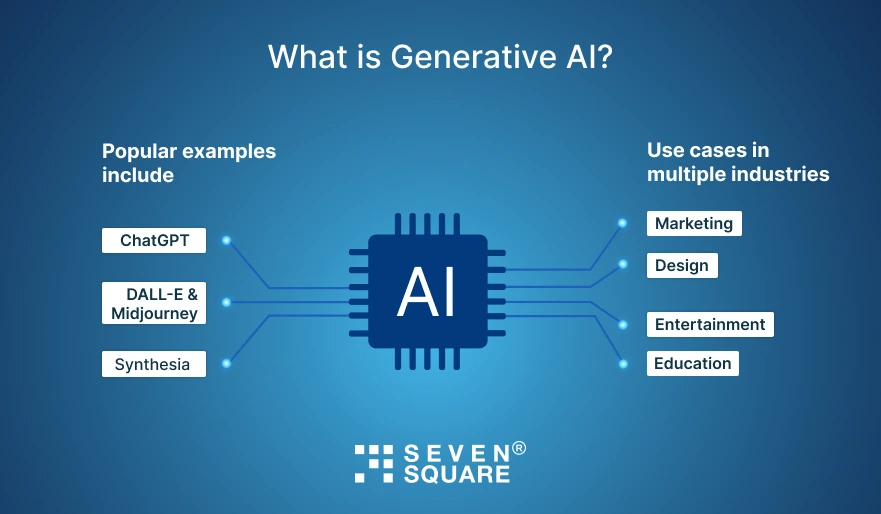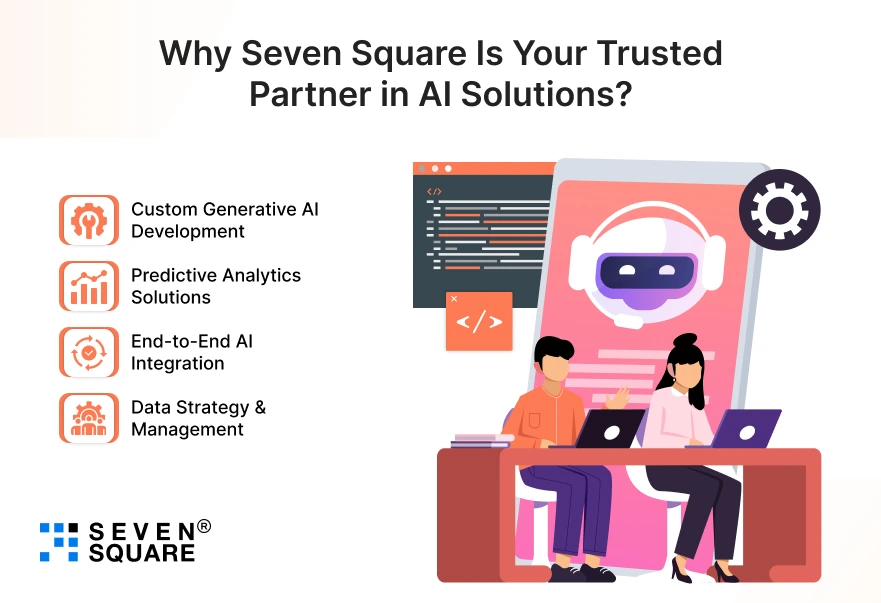Artificial Intelligence is changing everyday life faster than any technology before it.
Your phone finishes your sentences, your streaming app recommends your next favorite show, and design tools can create realistic images from a single line of text.
These incredible capabilities often come in different types of AI.
Two of the most impactful branches are Generative AI and Predictive AI.
- Generative AI acts like a creator, producing entirely new content, whether that’s a blog post, a photo-realistic image, or even a piece of music.
- Predictive AI, on the other hand, is a forecaster. It analyzes existing data to make informed predictions about what might happen next.
The difference between Generative AI vs Predictive AI might sound like a technical detail, but in practice, it’s the difference between creating a new marketing campaign and knowing which campaign will perform best before you launch it.
In this blog, we’ll break down Predictive AI vs Generative AI, explore their use cases, advantages, and limitations, and show how each is changing industries worldwide.
By the end, you’ll know not just the definitions, but exactly when and why to use each type of AI.
What is Generative AI? (The Creator)

Generative AI means artificial intelligence systems that are designed to create new content rather than simply analyzing existing information.
These systems learn from vast datasets, absorbing the patterns, styles, and structures they find.
Then, when prompted, they produce entirely new outputs that mimic the qualities of the training data without copying it directly.
Imagine telling an AI to “draw a futuristic city at sunset” and, within seconds, it delivers a vivid, original image. That’s Generative AI at work.
Popular examples include:
- ChatGPT: Generates human-like text for writing, customer support, or brainstorming.
- DALL-E & Midjourney: Create unique images from text prompts.
- Synthesia: Produces AI-generated videos with realistic avatars.
Generative AI use cases in multiple industries:
- Marketing: Writing ad copy, blog posts, and social captions at scale.
- Design: Creating graphics, product prototypes, and branding concepts.
- Entertainment: Composing music, generating scripts, & creating game assets.
- Education: Producing personalized learning content for students.
Generative AI is often compared to a digital artist or composer.
Instead of following strict instructions, it takes inspiration from what it has learned and invents something new.
This creative capability is already changing industries where innovation and originality are critical.
What is Predictive AI? (The Forecaster)
Predictive AI is all about anticipating the future.
It works by analyzing large sets of historical data to identify patterns and trends, then uses that information to forecast likely outcomes.
Predictive AI doesn’t produce brand-new data; instead, it helps you make informed decisions based on probabilities.
A simple example: A weather forecasting system. It doesn’t create new weather data; it studies historical climate patterns & current conditions to predict tomorrow’s temperature. The same logic applies in business, healthcare, finance, and more.
Popular examples include:
- Fraud detection systems in banking that flag suspicious transactions in real time.
- Recommendation engines like Netflix or Amazon that predict what you’ll want to watch or buy next.
- Predictive maintenance tools that alert factories when a machine is likely to break down.
Predictive analytics use cases include:
- Finance: Credit scoring, fraud prevention, and market trend forecasting.
- Healthcare: Predicting disease progression and optimizing treatment plans.
- Retail: Forecasting product demand to improve inventory management.
- Logistics: Route optimization for faster, cheaper deliveries.
Predictive AI is like having a skilled analyst who reads all the past reports and can give you the best possible guess for the future.
While it can’t guarantee accuracy, it drastically improves decision-making by reducing uncertainty.
Explore the Explore the Comparison between LLM vs Generative AI.
The Core Difference Between Generative and Predictive AI
Although both Generative AI and Predictive AI use machine learning, their purpose, process, and output are fundamentally different.
Generative AI learns patterns from data and then creates something entirely new. It focuses on producing novel outputs, from blog articles to synthetic voices to architectural designs.
Predictive AI, in contrast, learns from data to anticipate future outcomes. Instead of creating something new, it focuses on probabilities. It’s more like a weather forecaster or a chess player predicting the opponent’s next move based on past games.
Here’s a quick comparison:
| Aspect | Generative AI | Predictive AI |
| Core Functionality | Generates something entirely new by mimicking human creativity using deep learning models like GANs or transformers. | Predicts what is most likely to happen next using statistical models, regression, and machine learning algorithms. |
| Key Technologies | Generative Adversarial Networks (GANs), Variational Autoencoders (VAEs), Transformers (GPT, LLaMA). | Time series forecasting, regression analysis, classification models, decision trees, and neural networks. |
| Data Dependency | Requires large datasets to learn styles, formats, and patterns before creating realistic outputs. | Requires historical and structured datasets to identify correlations and make accurate predictions. |
| Example Use Cases | AI art creation, content generation (ChatGPT, DALL·E), synthetic data generation, game character design. | Sales forecasting, fraud detection, weather prediction, stock market analysis, & customer churn prediction. |
| Output Type | Creative and unstructured, often human-like and unique. | Structured, numerical, or categorical predictions, based on probabilities. |
| Level of Creativity | High, can produce innovative solutions beyond existing data. | Low, bound to existing patterns in data. |
| Industries Using It | Media, entertainment, marketing, gaming, design, healthcare (drug molecule creation). | Finance, retail, logistics, healthcare (diagnosis predictions), & manufacturing. |
| Example Tools | ChatGPT, Midjourney, Jasper AI, Runway ML. | Amazon Forecast, Google Cloud AI, IBM Watson, SAP Predictive Analytics. |
| Limitation | Risk of generating inaccurate or biased content; needs high-quality training data. | Predictions are limited by data quality; they cannot produce entirely new content. |
When to Use Generative AI vs Predictive AI?
Knowing when to use Generative AI vs Predictive AI is crucial for getting the results you want.
Use Generative AI when:
- You need creative outputs, such as marketing content, product prototypes, or visual designs.
- You want to explore new possibilities and generate innovative ideas.
- Your goal is to personalize content at scale for different audiences.
Use Predictive AI when:
- You’re making decisions based on likely future outcomes.
- You need to optimize processes, reduce risk, or forecast demand.
- You want to identify trends and patterns that guide business strategy.
Real-world example: A retail company might use Generative AI to design promotional materials for an upcoming holiday sale.
Then, they could use Predictive AI to determine which products will be most popular during that sale, ensuring they stock the right items in the right quantities.
Sometimes, the hybrid approach is the most powerful, combining Generative AI’s creative power with Predictive AI’s foresight, which can give you both innovative ideas and confidence in their success.
This pairing is becoming increasingly common in marketing, product design, and even healthcare solutions.
Why Seven Square Is Your Trusted Partner in AI Solutions?

Our team combines deep expertise in Generative AI, Predictive AI, and custom AI-driven software development to deliver business-ready solutions.
- Custom Generative AI Development: From chatbots and content generators to synthetic media creation.
- Predictive Analytics Solutions: Demand forecasting, customer churn prediction, and trend analysis.
- End-to-End AI Integration: Bringing AI into your apps, workflows, and products without disrupting your existing systems.
- Data Strategy & Management: Ensuring your AI runs on clean, well-structured, and secure data.
Our approach is fast, collaborative, and quality-driven, ensuring you get to market sooner without compromising performance.
Want to Integrate AI in Your Solution? Contact Us Now!
Generative AI vs Predictive AI: How Each is Changing the World?
When evaluating AI for your business, research, or product development, understanding the differences between generative AI and predictive AI is important.
While both are powerful, their goals, architectures, data requirements, and industry applications vary significantly.
1. How Are the AI Models Structured?
- Generative AI models vary widely from transformer-based architectures for text generation (like GPT) to GANs and diffusion models for images, and deep reinforcement learning for creative problem-solving.
- Predictive AI models often rely on statistical modeling, decision trees, regression analysis, and machine learning algorithms like random forests, gradient boosting, or neural networks optimized for classification and forecasting tasks.
- Key takeaway: Generative AI is often multi-modal, designed to handle different media types, while predictive AI models are optimized for accuracy in numerical or categorical predictions.
2. What Problems Do They Solve Best?
- Generative AI is best in areas where originality, customization, and expression are key, such as marketing content creation, AI-driven design, product personalization, training simulations, and entertainment.
- Predictive AI dominates in areas where accuracy, optimization, and prevention matter, such as supply chain forecasting, medical diagnosis predictions, financial risk scoring, and customer churn prevention.
- Real-world example: In retail, generative AI can create engaging product descriptions and ads, while predictive AI determines which products to stock based on buying patterns.
3. How Accurate and Consistent Are They?
- Generative AI can produce highly creative outputs but may introduce randomness or unexpected variations, which are great for brainstorming but less reliable for strictly factual or structured tasks.
- Predictive AI aims for deterministic, measurable accuracy. While no model is perfect, predictive AI is often more consistent in performance, especially in repeatable, data-driven tasks.
- Generative AI offers creative freedom with variability.
- Predictive AI offers precision and consistency with forecasting.
Choosing between generative AI and predictive AI (or using both in synergy) depends on your goals, data availability, and resource constraints.
Businesses that understand the difference can create more targeted, cost-effective AI strategies.
FAQs
- Generative AI creates new, original content like text, images, or audio based on learned patterns, while Predictive AI forecasts future outcomes using historical data and statistical models.
- Predictive AI excels in finance, supply chain management, retail demand forecasting, predictive maintenance, and fraud detection, helping organizations make data-backed, future-focused decisions with improved accuracy.
- Yes, businesses often integrate Generative AI for creative output and Predictive AI for data forecasting, creating smarter systems that both innovate and strategically plan future actions.
- Generative AI often requires larger computational resources and extensive training data, making it costlier.
- Predictive AI models are generally simpler, cheaper, and faster to train, especially for specific forecasting tasks.
- Predictive AI relies on high-quality historical data, relevant metrics, and clean datasets.
- The more accurate and structured the input data, the better the predictive accuracy.